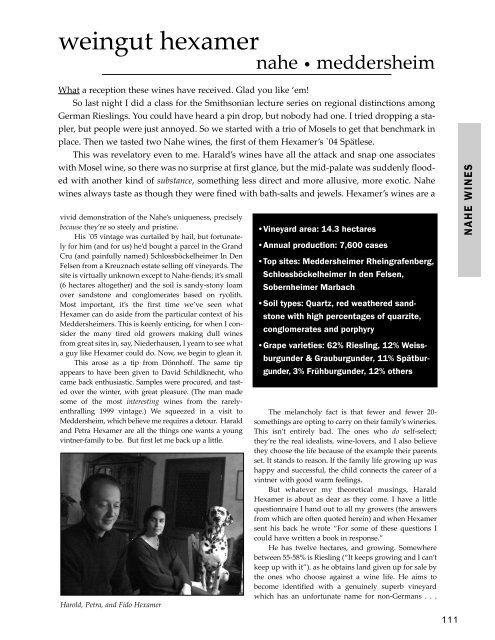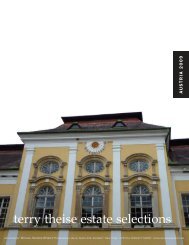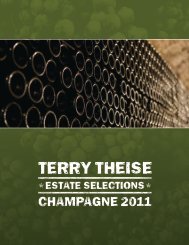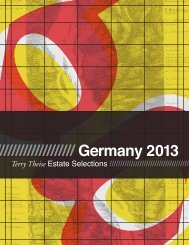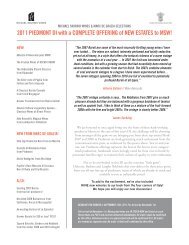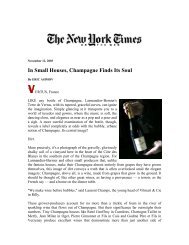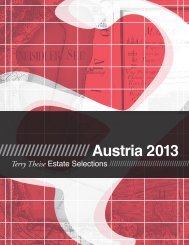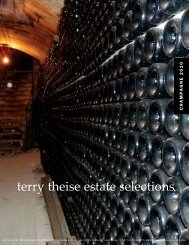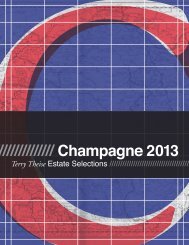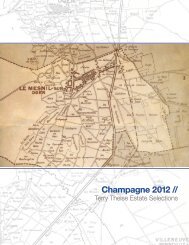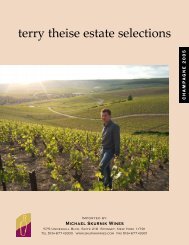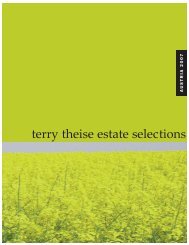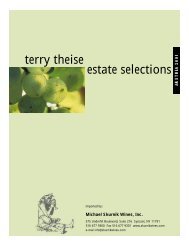German Catalog 2006 USE THIS ONE.qxp - Michael Skurnik Wines
German Catalog 2006 USE THIS ONE.qxp - Michael Skurnik Wines
German Catalog 2006 USE THIS ONE.qxp - Michael Skurnik Wines
Create successful ePaper yourself
Turn your PDF publications into a flip-book with our unique Google optimized e-Paper software.
weingut hexamer nahe • meddersheim<br />
What a reception these wines have received. Glad you like ‘em!<br />
So last night I did a class for the Smithsonian lecture series on regional distinctions among<br />
<strong>German</strong> Rieslings. You could have heard a pin drop, but nobody had one. I tried dropping a stapler,<br />
but people were just annoyed. So we started with a trio of Mosels to get that benchmark in<br />
place. Then we tasted two Nahe wines, the first of them Hexamer’s `04 Spätlese.<br />
This was revelatory even to me. Harald’s wines have all the attack and snap one associates<br />
with Mosel wine, so there was no surprise at first glance, but the mid-palate was suddenly flooded<br />
with another kind of substance, something less direct and more allusive, more exotic. Nahe<br />
wines always taste as though they were fined with bath-salts and jewels. Hexamer’s wines are a<br />
vivid demonstration of the Nahe’s uniqueness, precisely<br />
because they’re so steely and pristine.<br />
His `05 vintage was curtailed by hail, but fortunately<br />
for him (and for us) he’d bought a parcel in the Grand<br />
Cru (and painfully named) Schlossböckelheimer In Den<br />
Felsen from a Kreuznach estate selling off vineyards. The<br />
site is virtually unknown except to Nahe-fiends; it’s small<br />
(6 hectares altogether) and the soil is sandy-stony loam<br />
over sandstone and conglomerates based on ryolith.<br />
Most important, it’s the first time we’ve seen what<br />
Hexamer can do aside from the particular context of his<br />
Meddersheimers. This is keenly enticing, for when I consider<br />
the many tired old growers making dull wines<br />
from great sites in, say, Niederhausen, I yearn to see what<br />
a guy like Hexamer could do. Now, we begin to glean it.<br />
This arose as a tip from Dönnhoff. The same tip<br />
appears to have been given to David Schildknecht, who<br />
came back enthusiastic. Samples were procured, and tasted<br />
over the winter, with great pleasure. (The man made<br />
some of the most interesting wines from the rarelyenthralling<br />
1999 vintage.) We squeezed in a visit to<br />
Meddersheim, which believe me requires a detour. Harald<br />
and Petra Hexamer are all the things one wants a young<br />
vintner-family to be. But first let me back up a little.<br />
Harold, Petra, and Fido Hexamer<br />
•Vineyard area: 14.3 hectares<br />
•Annual production: 7,600 cases<br />
•Top sites: Meddersheimer Rheingrafenberg,<br />
Schlossböckelheimer In den Felsen,<br />
Sobernheimer Marbach<br />
•Soil types: Quartz, red weathered sandstone<br />
with high percentages of quarzite,<br />
conglomerates and porphyry<br />
•Grape varieties: 62% Riesling, 12% Weissburgunder<br />
& Grauburgunder, 11% Spätburgunder,<br />
3% Frühburgunder, 12% others<br />
The melancholy fact is that fewer and fewer 20somethings<br />
are opting to carry on their family’s wineries.<br />
This isn’t entirely bad. The ones who do self-select;<br />
they’re the real idealists, wine-lovers, and I also believe<br />
they choose the life because of the example their parents<br />
set. It stands to reason. If the family life growing up was<br />
happy and successful, the child connects the career of a<br />
vintner with good warm feelings.<br />
But whatever my theoretical musings, Harald<br />
Hexamer is about as dear as they come. I have a little<br />
questionnaire I hand out to all my growers (the answers<br />
from which are often quoted herein) and when Hexamer<br />
sent his back he wrote “For some of these questions I<br />
could have written a book in response.”<br />
He has twelve hectares, and growing. Somewhere<br />
between 55-58% is Riesling (“It keeps growing and I can’t<br />
keep up with it”). as he obtains land given up for sale by<br />
the ones who choose against a wine life. He aims to<br />
become identified with a genuinely superb vineyard<br />
which has an unfortunate name for non-<strong>German</strong>s . . .<br />
111<br />
NAHE WINES


